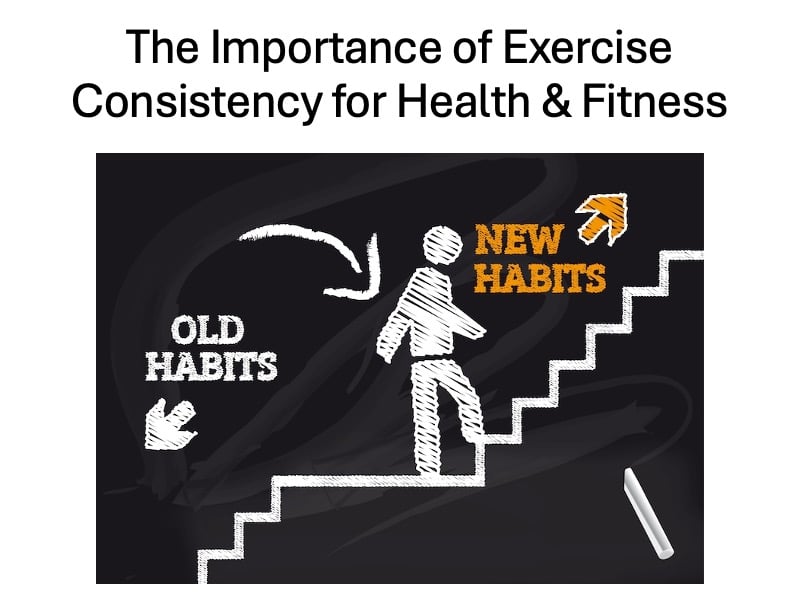The Importance of Exercise Consistency for Health & Fitness
Exercise consistency is the single most important variable in any long-term health and fitness journey.
While flashy workout programs and rapid transformations often dominate social media, the reality is that meaningful progress is built through repetition, routine, and patience.
Important: Sustainable fitness is not about pushing yourself to the brink once in a while; it’s about showing up regularly, even when you don’t feel at your best.
The human body thrives on adaptation, and consistent movement provides the stimulus necessary for that adaptation to occur.
Whether you’re lifting weights, walking daily, swimming, or following a bodyweight program at home, repeated exposure to physical activity helps strengthen your muscles, balance your hormones, and improve your cardiovascular function over time.
Sporadic high-intensity efforts may give the illusion of progress, but without regularity, the body cannot develop the necessary habits and physiological adaptations to stay strong and injury-free.
Consistency also plays a crucial psychological role.
Forming healthy habits for exercising reduces decision fatigue, increases adherence, and creates a powerful feedback loop of motivation and accomplishment.
Research indicates that consistent routines, particularly when performed at the same time each day, can foster stronger behavioral patterns and lead to improved physical outcomes (Schumacher et al., 2023).
This is particularly important for people balancing busy lives, as consistent exercise becomes a form of structured self-care that supports both mental and physical well-being.
In the long run, exercise consistency outperforms intensity, complexity, or novelty—every time.
What is Exercise Consistency?
Exercise consistency refers to maintaining a regular and sustainable workout routine over time, regardless of how intense or complex each session is.
It’s not about working out every single day or pushing yourself to exhaustion, but rather about showing up on a regular schedule that fits your lifestyle, goals, and recovery needs.
This could mean exercising three to five times per week, sticking to the same workout time each day, or following a structured program without skipping sessions.
Consistency helps your body adapt, builds momentum, and transforms movement into a natural part of your daily rhythm.
Rather than chasing perfection or short-term results, exercise consistency emphasizes the power of progress built through repetition and routine.
Benefits of Good Exercise Consistency

Building a workout routine is one thing, but sticking to it is where the real transformation happens.
Good exercise consistency unlocks a wide range of physical, mental, and emotional benefits that can’t be replicated by occasional bursts of effort.
From better performance to reduced injury risk and improved mood, staying consistent with your training creates a compounding effect that supports long-term health and fitness.
Let’s explore the science-backed benefits of exercise consistency that make consistency the true secret weapon of sustainable fitness.
Consistency Turns Fitness Into a Habit
You may have started a fitness routine and jumped ship before your New Year’s fitness resolution had time to go cold!
Sticking to a fitness routine is key, and by following a tailored workout plan and committing to regular sessions, you start to shift exercise from something you have to do to something you just do.
This is the most important thing because habits are powerful.
Studies have shown that it takes an average of 66 days to form a new habit (Singh et al., 2022).
This means that those who give up on their New Year’s resolution by January 31st haven’t given themselves enough time, or they’ve chosen a fitness routine that’s completely unsustainable.
Once fitness becomes a part of your life, you don’t have to rely on motivational willpower; you simply just show up even when you’re not feeling your best.
Additionally, following a tailored workout plan means you’re also more likely to enjoy your routine.
Enjoyment is the key to adherence, not pushing for the burn every single time.
You Make Steady Progress and Breakthroughs
While dramatic results often dominate fitness culture, real, lasting change is the product of consistent, incremental progress.
Just as martial artists earn their black belts through years of disciplined practice, long-term fitness gains are built one workout at a time.
Every session contributes to a foundation of physical and neurological adaptations, even when it feels small or insignificant.
Physiologically, the body responds to progressive overload (gradually increasing stress placed on muscles and joints) through a principle known as SAID (Specific Adaptation to Imposed Demands).
However, when workouts are erratic or too intense too soon, they can cause burnout, disrupt recovery, and halt progress.
Overtraining without sufficient rest or consistency can lead to fatigue, injury, and a loss of motivation.
In contrast, a well-paced, consistent workout routine supports steady improvement and positions you to break weightlifting plateaus or other performance barriers.
Whether it’s lifting a heavier weight, running your first 5K, or simply feeling stronger during daily activities, these breakthrough moments are often the result of accumulated effort, not one magical workout.
However, it’s common to feel frustrated during plateaus or when progress slows.
This is where many people abandon their routines or chase novelty with new programs.
But instead of constantly “confusing the muscle,” the smarter approach is to stay the course.
Your body needs time to adapt, and consistency provides the conditions for that adaptation to occur.
Ultimately, exercise consistency allows you to progress with less mental fatigue and fewer setbacks.
By prioritizing structure over intensity and patience over perfection, you create the foundation for long-term fitness success, without burning out or falling off track.
A Reduced Risk of Injury and Better Recovery
Inconsistent high-intensity training often leads to injuries, fatigue, or illness.
The body thrives on gradual adaptation.
Sporadic workouts shock the system, while consistent moderate training allows your joints, muscles, and nervous system to adjust and recover properly.
Research has shown that routine, low-to-moderate intensity exercise improves cardiovascular fitness and VO2 max over time without overtaxing the nervous system (Schumacher et al., 2023).
Moreover, when you train regularly, you become more attuned to subtle signs of fatigue, stress, or pain, allowing for smarter adjustments before setbacks occur.
Rest, recovery, and proper warm-ups are easier to manage when workouts are spaced and paced consistently.
This improves long-term performance and reduces your injury risk dramatically.
Improved Mental Health and Motivation
Exercise consistency doesn’t just build muscle; it builds mental resilience.
Repeated workouts elevate endorphin levels, reduce symptoms of anxiety and depression, and improve cognitive clarity.
You’re not only training your body, you’re reinforcing a sense of control and purpose.
Completing your workout, even when you don’t feel like it, is a powerful psychological win.
Over time, these small victories create a positive feedback loop, helping you rewire your self-image and boost self-efficacy.
Establishing consistent exercise routines also makes it easier to manage stress and anxiety. Knowing that you’ve carved out time for movement—even 30 minutes a day—can ground your day and act as an emotional anchor during unpredictable periods.
How to Maintain Exercise Consistency
One of the most effective strategies for maintaining exercise consistency is establishing a set time each day to move your body.
Whether you prefer early morning workouts or evening training sessions, keeping your schedule consistent can help turn exercise into a non-negotiable part of your routine.
A 2023 feasibility study demonstrated that individuals assigned to fixed morning or evening workouts achieved significantly higher levels of moderate-to-vigorous physical activity (MVPA) than those given the freedom to choose their workout time each day (Schumacher et al., 2023).
This suggests that predictability, not flexibility, may be the key to long-term adherence.
Similarly, research on successful long-term weight loss maintainers found that those who exercised at the same time daily, especially those who did morning workouts, reported greater MVPA levels and more automatic exercise habits (Schumacher et al., 2019).
The takeaway?
Time-of-day consistency not only reduces decision fatigue but also strengthens habit formation, making it easier to stay active in the long run.
Creating a dependable workout rhythm, even if it’s just 30 minutes a day, can reinforce structure, improve adherence, and anchor your day with a positive health habit.
Final Thoughts: Understanding the Importance of Exercise Consistency for Long-Term Results
The importance of consistency for health and fitness extends far beyond simply adhering to a workout schedule; it’s about cultivating a sustainable relationship with movement and self-care.
Exercise consistency teaches patience, discipline, and adaptability, qualities that extend well beyond the gym or training floor.
When you move your body regularly, you signal to your mind that your health matters every day, not just when motivation strikes.
Over time, this rhythm creates both physical and psychological resilience, forming a lifestyle built on commitment rather than fleeting bursts of effort.
True fitness success is not about perfection; it’s about permanence.
As my high school coach once told me, “Practice makes permanent, not perfect.”
The same holds true for exercise: the more consistently you show up, the more ingrained these healthy habits become.
Whether your goal is to increase strength, improve endurance, or simply feel better, consistent action will always outperform sporadic intensity.
Ultimately, long-term progress is achieved through consistent effort, mindful recovery, and a commitment to the process.
By valuing consistency above all else, you turn exercise into a lifelong habit, and your body, mind, and spirit will thank you for it.
This website does not provide medical advice. This website site does contain affiliate links, and purchases may earn a commission.
Read my Medical Disclaimer, Review Disclaimer, and Publishing Policies for more details. Use of this site indicates acceptance of these terms.



